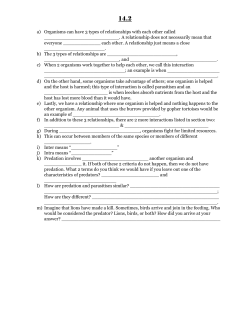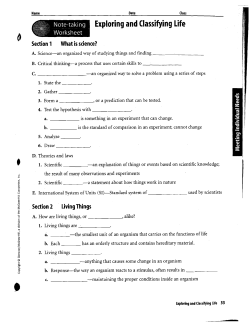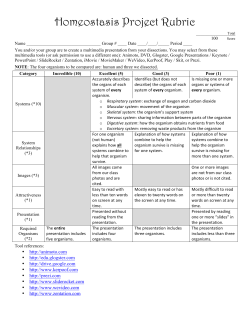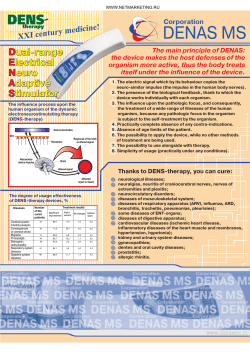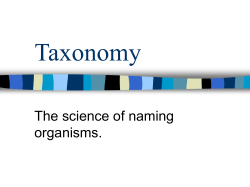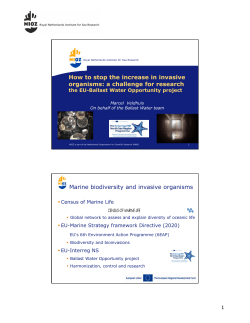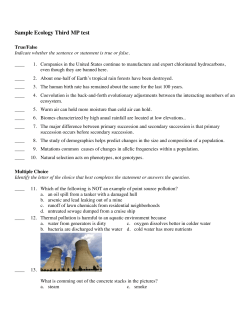
Threatened, Endangered and Extinct Species Standard 4.7
Threatened, Endangered and Extinct Species Standard 4.7 How many species are on Earth? Scientists identified about 1.75 million Could be as many as 100 million Species can appear and disappear Extinction An extinct species is one that no longer exists. Extinction is a natural process. The rate of extinction is increasing due to human activities such as pollution. Removing organisms will change ecosystems. Effects of Extinction Causes a loss of animals that help cycle nutrients through the environment Lose plants that provide food and oxygen Loss of organisms that could supply new medications Biodiversity Biodiversity – refers to the great variety of organisms on Earth Three major levels – Genetic – Species – Ecosystem Biodiversity Also involves genetic variation within a particular species Human Examples – Physical Traits – hair color, height, eye color and susceptibility to disease Pennsylvania’s Biodiversity More than 20,000 different species in PA Besides animals other common organisms in PA include: – Insects, plants, fungi and lichens Scientists in PA are trying to maintain biodiversity by listing and monitoring as many species as possible. Lichens Pennsylvania’s Biodiversity 4% 7% 23% 3% Plants/Algae Insects 16% Fungi/Lichens Vertebrates Protists Non-insect invertebrates 47% Interactions Among Organisms Remember the food web – all organisms rely on other organisms Predator-prey relationships help to keep an ecosystem in balance – An organism of one species (the predator) eats a living organism of a different species (the prey) Examples: polar bears eat fish, lions that eat zebras, robins that eat worms. Examples Predator-Prey Interactions Among Organisms As the prey population increases, ecosystems can support more predators As the prey population decreases, the lack of prey causes the predator population to decrease This allows for a stable carrying capacity This also allows the strongest and fittest members of the community to survive Other relationships Symbiosis – organisms live closely together over a long period of time Can be parasitic, mutualistic, or commensalistic Other relationships Parasitism – one species, the parasite, feeds on a second organism the host Parasite harms the host by living in or on it Examples: ticks or mosquitoes that live off of the host Parasitism promotes ecosystem stability by preventing the populations of some organisms from becoming too large Parasitism Example Other relationships Mutualism – both species involved in the symbiotic relationship benefit Examples: – Bees and flowers – bees feed on flower nectar, and spread flower pollen in the process – Lichens – are two organisms, alga and fungus that grew together • The algae undergo photosynthesis and provide food for the fungi and itself while the fungi gathers water and minerals to share with the algae Mutualism Example Other relationships Commensalism – one organism benefits while the other is not affected Example: Trees in the rain forest block sunlight from reaching the ground, therefore plants such as orchids establish roots high in tree branches, growing through the high canopy to reach sunlight – The orchid can receive moisture and nutrients from the air and does not harm the tree The Human Impact When humans destroy habitats, kill off species or pollute the natural environment biodiversity often decreases As a result ecosystems break down Adaptations Adaptation – special modification or characteristic that helps an organism better survive in its environment, and which typically develops over time or may be passed down from one generation to another Adaptations can be structural (or physical), behavioral (or responsive) Structural or Physical Adaptations Examples: desert plants with thick, wax-coated leaves Predator birds – bald eagles have keen eyesight and are capable of flying at great speeds in order to catch prey Behavioral or Response Adaptations Example: An animal that cannot regulate its internal temperature, such as lizards or snakes, sit in the sun on cool days to warm itself – Retreats to its burrow on hot days to cool itself Structural Adaptations Structural adaptations - are physical characteristics that help an organism survive in its environment They help animals to perform basic tasks, such as moving or eating Examples – Meat-eating animals have sharp incisors for killing prey Plant eating animals have large, flat teeth that allow them to grind plants into pieces that are easily swallowed Structural Adaptation Examples Animals in deserts thousands of miles apart have the same types of adaptations Plants that grow in the deep shade of forests have dark green leaves that increase their ability to catch any light that reaches the forest floor Chameleon is a lizard that changes its color to match its surroundings at the time Chameleon Butterflies Mimicry – an adaptation in which one species copies the appearance or behavior of another species Recall the “Animal Camouflage” Article – Viceroy butterfly protects itself by looking like the monarch butterfly, which birds avoid because of their bad taste Adaptation Advantages Decreases competition Allows species niche to be different Allows species survival Behavioral Adaptations The way an organism acts or responds to its environment in order to survive Can be reflexive or instinctive Reflexive Behaviors A behavior that is triggered automatically by something outside an organism The behavior happens without the organism thinking about it – Example: Pulling your hand off of something hot – Example: Running from a loud noise Instinctive Behaviors A behavior that an organism carries out because it is genetically prone to do so These are natural reactions – Examples: Traveling in a group (safety in numbers) – To look bigger and more frightening a blowfish expands its body with air – Male bioluminescent fireflies flash light to attract females Other Adaptations Hibernation – animals decrease their activity during winter months after constant eating during the fall Estivation – to avoid the heat of summer some frogs, lizards and ground squirrels sleep through the summer in a dormant state Other Adaptations Migration – allows animals to find more favorable climates or feeding conditions after a change in climate Courtship Rituals Instinctive behaviors because they encourage animal reproduction – Male birds use songs to attract female birds Structural adaptations – Male peacock struts using his colorful tail feathers so females will notice him Survival of the Fittest Which will survive in the snowy climate of northern Alaska? – White rabbit with long thick fur or – Gray rabbit with short fur Natural Selection Most helpful traits are passed on to future generations – Charles Darwin Process that makes it more likely that organisms with the best characteristics for survival in a specific environment will survive, reproduce, and pass on their advantageous genetic traits to offspring Populations In order to evolve so the most advantageous adaptations become common three things must happen 1. Trait must vary within the species 2. The adaptation must be one that parents can pass on to offspring genetically 3. One version of the adaptation must benefit the members to that they survive and reproduce more than the members who do not have it May occur quickly or take millions of years Amazing Adaptations Ice fish – Evolved to have no red blood cells and no hemoglobin – Oxygen dissolves in the blood – Allows fish to survive in the extreme cold Human Impact Negative – Destroying habitat – Polluting rivers, lakes Positive – Repair damage already done – Protect whole ecosystems (conserve plants and animals) – Maintain biodiversity – Wildlife refuges – Protect endangered species Protecting Endangered Species Government protected habitats Bred in captivity and then returned to wild – Examples: bald eagle, California condor Restrictions to hunting Bald Eagle In 1700s population of 100,000 in 1970 population of less than 3,000 Cause – unregulated hunting and habitat destruction, DDT pesticide DDT – caused eagles to produce eggs with shells that were too thin Solution – Government protected eagle’s nest, bred in zoos, banned use of DDT Population increased but still endangered Bald Eagle PABS Pennsylvania Biological Survey (PABS) – Helps to maintain state’s biodiversity – Tracks and monitors plants and animals – Coordinates programs, surveys and research on PA wildlife – Developing bio-reserves throughout PA • Help conserve ecosystems throughout the state Endangered Species Act ESA – US law that governs the protection of species whose populations are in decline and could be in danger of extinction The law forbids hunting, killing, collecting or harming of species listed as endangered or threatened. 3 categories – Threatened, Endangered, Extinct ESA Categories Threatened – A species that still has many individuals in the wild but whose numbers are dwindling to a point at which the species could become endangered – Example: Green snake Endangered – A species that has so few individuals remaining that extinction is a possibility in the near future – Example: Delmarva fox squirrel ESA Categories Extinct – A species that no longer exists – Example: Passenger pigeon Factors Prone to Extinction Specific food requirements Specific habitat or nesting requirements High on food chain or food web – These animals are more vulnerable to pollution Migration Reproduce a low rate Limited habitat range Interference with human activities Help for Species in Danger National Marine Fisheries Service and US Fish and Wildlife Service – Propose species the ESA will protect – Can delist species if species is no longer in need of protection • Happened to bald eagle in 1999 Humans have accelerated extinction between 1,000 and 10,000 times
© Copyright 2024
